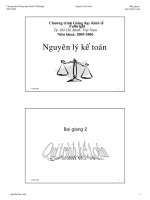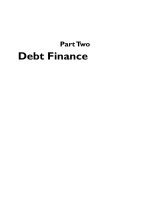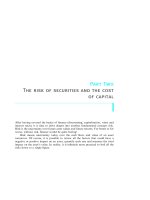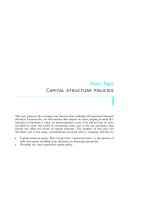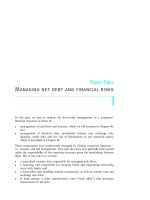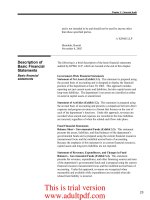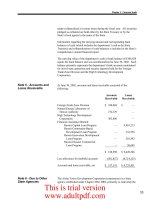Chapter 2 income statement
Bạn đang xem bản rút gọn của tài liệu. Xem và tải ngay bản đầy đủ của tài liệu tại đây (151.88 KB, 22 trang )
OPEN UNIVERSITY HCMC
MBA PREPARATORY COURSE
Principles of Financial
Accounting
06/04/16
NGUYEN TAN BINH - PHAN DUC DUNG
1
Chapter 2
Income statement
06/04/16
NGUYEN TAN BINH
2
Learning Objectives
After studying this chapter, you should be able
to:
Explain how accountants measure income.
Use the concepts of recognition, matching, and cost
recovery to record revenues and expenses.
Prepare an income statement and show how it is
related to a balance sheet.
Calculate operating cash flows and show how cash
flow differs from income.
06/04/16
NGUYEN TAN BINH
3
Introduction to Income
Measurement
Income is a measurement of evaluating
performance.
All income should be measured in the same
way following a common set of rules.
Using a common set of rules allows decision
makers to compare the performance of one
company with that of other companies
because measurement is the same in all
companies.
06/04/16
NGUYEN TAN BINH
4
Operating Cycle
Operating cycle - the time span during which
cash is used to acquire goods and services,
which in turn are sold to customers, who in turn
pay for their purchases, with cash
Buy
Cash
7,000
Merchandise
Inventory
7,000
Sell
Accounts
Receivable
10,000
Collect
06/04/16
NGUYEN TAN BINH
5
Revenues and Expenses
Revenues (sales) - gross increases in
owners’ equity arising from increases in
assets received in exchange for the
delivery of goods or services to customers
Expenses - decreases in owners’ equity
that arise because goods or services are
delivered to customers
06/04/16
NGUYEN TAN BINH
6
Revenues and Expenses
Income (profit) - the excess of
revenues over expenses
Revenues - Expenses = Profit
Retained income - additional owners’
equity generated by income or profits
Revenues increase owners’ equity.
Expenses decrease owners’ equity.
06/04/16
NGUYEN TAN BINH
7
Accrual and Cash Basis
The most common ways of measuring
income are the accrual basis and the cash
basis.
Accrual basis - recognizes the impact of
transactions for the time periods when revenues
and expenses occur even if no cash changes
hands
Cash basis - recognizes the impact of
transactions only when cash is received or
disbursed
06/04/16
NGUYEN TAN BINH
8
Accrual and Cash Basis
Under the accrual basis:
Revenues are recorded when earned.
For example, a sale on account is recorded as
revenue when the transaction takes place even
though the seller receives no cash at that moment.
Expenses are recorded when incurred.
For example, a purchase on account is recorded as
an expense when the transaction takes place even
though the buyer disburses no cash at that
moment.
06/04/16
NGUYEN TAN BINH
9
Accrual and Cash Basis
Under the cash basis:
Revenues are recorded when a sale is
made for cash at the time when the cash
changes hands.
Expenses are recorded when a purchase is
made for cash at the time when the cash
changes hands.
06/04/16
NGUYEN TAN BINH
10
Accrual and Cash Basis
The accrual basis is the current
standard for the measurement of
income.
06/04/16
Presents a more complete summary of
what happened during the year
Recognizes revenues when they are
earned and expenses when they are
incurred
Matches expenses to revenues
NGUYEN TAN BINH
11
Recognition of Revenues
Recognition - a test to determine whether
revenues should be recorded in the financial
statements for a given period
To be recognized, revenue must be:
Earned - goods are delivered or a service is
performed
Realized - cash or a claim to cash (credit) is
received in exchange for goods or services
06/04/16
NGUYEN TAN BINH
12
Matching and Cost Recovery
Two types of expenses:
Product costs - those linked with
revenue earned in the same period
Cost of goods sold or sales commissions
Without sales there is no cost of goods sold or
sales commissions.
Period costs - those linked with the time
period itself
Rent or other administrative expenses
06/04/16
Rent is paid even if no sales are made.
NGUYEN TAN BINH
13
Matching and Cost Recovery
Matching - recording of expenses in the
same time period as the related revenues
are recognized
Cost recovery - concept by which some
purchases of goods or services are
recorded as assets and “expired” later
because the costs are expected to be
recovered in future periods
An example is rent for one year paid in
advance.
06/04/16
NGUYEN TAN BINH
14
Matching and Cost Recovery
Another example of matching and cost
recovery is depreciation.
Depreciation - the systematic allocation of
the acquisition cost of long-lived assets or
fixed assets to the expense accounts of
particular periods that benefit from the use of
the assets.
06/04/16
NGUYEN TAN BINH
15
Expansion of the
balance sheet equation
Assets = Liabilities + Owners’ Equity
Assets = Liabilities + Paid-in Capital + Retained Income
Assets = Liabilities + Paid-in Capital + Revenues - Expenses
06/04/16
NGUYEN TAN BINH
16
The Income Statement
Income Statement - a report of all
revenues and expenses pertaining to a
specific time period
Net income - the remainder after all
expenses (including income taxes) have
been deducted from revenue
Often seen as the “bottom line”
Net loss - the excess of expenses over
revenues
06/04/16
NGUYEN TAN BINH
17
The Income Statement (IS)
SAIGON MILK COMPANY
Income Statement
for the Year Ended December 31, 2005
(in millions VND)
Sales
Expenses:
Wages expense
Rent expense
Utilities expense
Depreciation expense
Total expenses
Net Income
06/04/16
10,000
1,800
3,500
1,500
400
7,200
2,800
NGUYEN TAN BINH
18
Relationship between IS and BS
The balance sheet provides a
snapshot of an entity’s
financial
position at
an instant in time.
The income statement provides a
moving picture of events over a
span of time and explains the
changes that have taken place
between balance sheet dates.
06/04/16
NGUYEN TAN BINH
19
Cash Flows Statement (CFS)
Income does not measure an entity’s
performance in generating cash, especially
if the income is measured using the
accrual basis.
In a way, accountants use both the accrual
and cash bases.
The accrual basis is used in the income
statement.
The cash basis is used in the cash flows
statement.
06/04/16
NGUYEN TAN BINH
20
Cash Flows Statement
Statement of cash flows - reports the
cash receipts and cash payments of an
entity during a particular period
It summarizes activity over a period of time,
so it must be labeled with the exact period
covered.
• It details the changes in the cash
account, much like the income
statement which shows changes in
retained earnings.
06/04/16
NGUYEN TAN BINH
21
The Language of Accounting
in the Real Life
Organizations use different terms to describe
the same concept or account.
Net Income
Retained Income
Net Earnings
Profit
Retained Earnings
Reinvested Earnings
Earnings retained for use in the
business
Profit employed in the business
References:
Horngren, Introduction to financial accounting
06/04/16
NGUYEN TAN BINH
22
